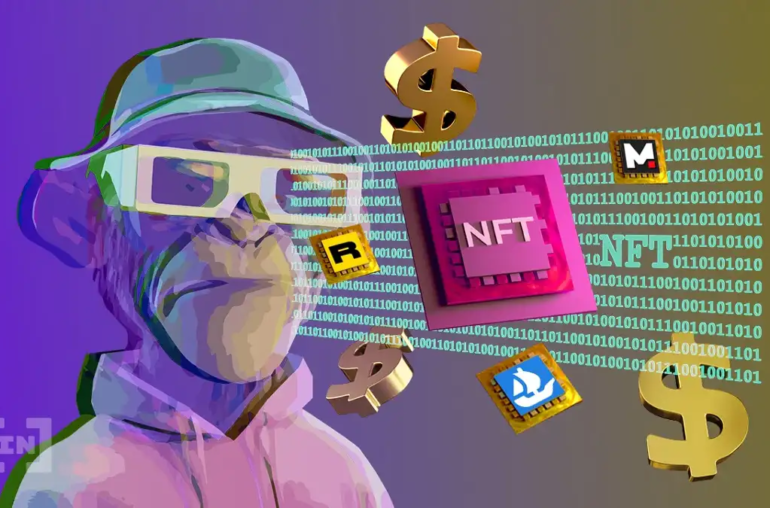Amid the frigid conditions of the ongoing crypto winter, non-fungible token (NFT) trading volume has decreased substantially since the third quarter of last year. While the NFT boom brought about a wave of popular PFP projects and multimillion-dollar JPEG sales, these trends became less prolific as the NFT market appeared to lose steam.
But in late September one artist made $17 million from selling out of mint passes to his new generative art NFT collection – a promising sign that interest in the NFT market had been reignited by these algorithmic-based designs.
Tyler Hobbs, the artist behind the collaborative generative art experiment, sold 900 of these mint passes, each priced at 14 ETH (about $18,729 at the time). The project highlighted the concept of audience curation into a generative art collection – the QQL algorithm is open to the public but only mint pass holders can mint their favorite creations as NFTs and become a part of the official collection.
“I think the value [of the collection] is around the collector, contributing to the work itself and becoming part of the story of QQL and the line of artworks that are evolving over time,” Hobbs told CoinDesk.
Hobbs is well known for generating buzz around an NFT project and has become a household name in the generative art NFT space. His flagship NFT collection Fidenza was minted in June 2021 via generative art platform Art Blocks, and in the months since it has continued to swell in popularity. In August 2021, Fidenza #313 sold for 1,000 ETH ($3.3 million) and, according to data from NFT marketplace OpenSea, the collection’s trading volume has ballooned to over 53,000 ETH, or about $82 million.
Hobbs joins a growing number of NFT artists and collectors that are embracing algorithmic art and the evolution of digital art creation.
Generative art is a method of creating work based on a set of instructions, whether it be analog or computational. As the art form has expanded, it has embraced the use of autonomous systems or algorithms to randomly generate content.
More recently, NFTs as a medium for artistic expression have brought these types of work and the artists behind them out from the shadows.
Jordan Kantor, artistic director of Art Blocks, told CoinDesk that generative art has been showcased through drawings and paintings throughout much of the 20th century. Yet, art movements in the 1960s, such as minimalism, along with the expansion of artificial intelligence and computing, helped propel generative art into the modern NFT space.
Specifically, he said Web3 technologies have “allowed for significant changes in the story of generative art,” and have opened up new pathways for artists to create and monetize their work. This includes building new tools for art creation, finding new ways to reach communities and developing new – and possibly more equitable – economic models.
Kantor added that merging generative art algorithms and blockchain technology can help artists to create “self-reflective work” that “most easily fits into the stories of contemporary art.”
As generative art continues to evolve as a medium, so too have the ways in which it has been used by NFT artists to enrich their communities and breathe new life into their artwork.
Emily Xie is the artist behind the Art Blocks collection Memories of Qilin, a code-based generative art project inspired by traditional East Asian art. Each output in the collection is an exploration of cultural folklore that leaves its interpretation up to the viewer.
“Part of the storytelling aspect of the series is this idea of collectivity and collective consciousness. We as a community are deciding the meanings of these pieces,” she told CoinDesk.
Xie, who studied art and obtained a master’s degree in computational programming, has successfully merged her two areas of expertise through generative art NFTs, and her Memories of Qilin collection has amassed a total trading volume of 3,055 ETH ($4.8 million) on OpenSea.
“I would do creative coding whenever I could, but I never imagined that there would be a way to actually live off of my art. So when I discovered NFTs for the first time it became possible,” said Xie.
Xie also noted that NFTs have helped new generations of collectors and creators discover generative art.
“[Generative art] has a very deep, rich history, but I think it has been at the margins of the art world for a very long time. What's interesting about generative art in the context of NFTs is that this medium has pushed generative art out to a wider audience,” said Xie.
While NFT platforms such as Art Blocks or OpenSea have swaths of generative art collections on their platforms, traditional auction houses have also taken notice.
Christie’s, the 255-year-old auction house at the forefront of the NFT boom, recently established the NFT division of its auction house called Christie’s 3.0. Its inaugural NFT collection was a series of artworks by 18-year-old visual artist Diana Sinclair, made up of five still works and four generative art videos.
Nicole Sales Giles, director of digital art sales, told CoinDesk that generative artwork appeals to more “tech-savvy” buyers looking to build out their art collections with intricate pieces.
Auction houses have also been successful at bringing together classic works of generative art and new algorithmic designs.
In April, Sotheby’s conducted a $2.3 million sale of generative art, showcasing the works of artists Vera Molnar, a 98-year-old generative artist who began her career in the 1940s, as well as Charles Csuri, an artist who emerged in the 1960s and who is credited with pioneering computer art and technology. On the roster were several other artists, including Hobbs.
Of the collectors who purchased these works, 69% were new to Sotheby’s and over a third of bidders were under 40 years old.
"[The sales data] shows that there is a real revival in this category. It's always been difficult to understand, mainly because of the coding and the artist's creative process that can become very 'techy' for more traditional collectors," Michael Bouhanna, co-head of digital art sales at Sotheby’s, told CoinDesk.
Bouhanna noted that while there’s an uptick in generative art sales and a greater focus in showcasing these types of digital art among auction houses, there’s still a need to educate collectors on the richness of this artistic medium.
“We really need to raise awareness to all types of collectors about this movement. So we do it through panels, creating relationships with some of the top collectors in the space and continuing to do new sales bringing in new and younger artists,” said Bouhanna.
While conversations around NFTs have shifted to focus on long-term utility, advocates for generative art NFTs praise the unique creative process that occurs between the artist and collector. Hobbs explained that this is one of the reasons he chose to make his QQL algorithm available to the public for free.
Some may argue doing this diminishes the value of the generated artwork that makes its way into the official NFT collection. However, Hobbs sees it as an opportunity to inspire creativity in the community he has grown.
“Even if they could never afford a mint pass, they're able to create beautiful artwork with it and they become part of the artistic conversation, said Hobbs. “And, in their own way, they've influenced the story of QQL and the final set of artwork.”
Related Quotes
The good news is that Apple (NASDAQ: AAPL) is now supporting non-fungible tokens (NFTs) in its App Store. Given Apple's massive influence in the tech world, this would seem to signal the future mass-market adoption of NFTs. The bad news is that Apple's new NFT rules are potentially so restrictive and onerous that there has already been blowback in the crypto community.
Christy Goldsmith Romero discusses her outlook on crypto and why the agency's current framework could be applied to crypto.
A look at the final Browns vs. Bengals injury report for Week 8.
In an interview with Decrypt, SEC Commissioner Hester Peirce explains why she believes the regulatory agency's approach to crypto and NFTs is far from ideal.
At least 146 people were killed in South Korea in a crowd crush during Seoul Halloween festivities Saturday, and officials say that number could rise.
Imoudu Chaba, 37, was jailed after admitting four counts of blackmail.
The Blockchain Association, a crypto lobbying organization based in Washington, D.C., filed for permission to support Ripple as a friend of the court in its ongoing defense against the Securities and Exchange Commission (SEC) late Friday. The SEC sued Ripple at the end of 2020 on allegations that it sold XRP as an unregistered security. The case has gone through a number of procedural motions since, and the parties recently filed their motions for summary judgement.
Burbank, CA – If you felt the swoosh of a ninja star just passing your ear, then you might be visiting the city of Burbank as they tote the bragging rights with the only museum in the world dedicated to the martial arts; the Martial Arts History…
JUNG YEON-JEHalloween parties in South Korea turned into scenes of true terror on Saturday, as stampedes left more than 150 dead, according to the latest reports out of Seoul .The nightmare occurred in the capital’s chic Itaewon neighborhood, where as many as 100,000 people reportedly came to party for the first Halloween since the easing of pandemic safety precautions. Authorities initially reported the incident resulted only in “cardiac arrests”—but at a press conference the head of the local
Against all odds, Bitcoin (BTC) is back: the original cryptocurrency passed the $20,000 price point this week amidst a major surge in value. The rest of the crypto market has enjoyed the renewed investor confidence this motion has brought.
(Bloomberg) — Bitcoin looks set for gains in October, defying a recent streak of monthly losses as the macro picture shows hints of improving and cryptocurrency market data improve.Most Read from BloombergTesla Engineers Visit Twitter Office to Review Code for MuskSeoul Stampede Leaves Over 150 Dead at Halloween FestivitiesMusk’s Twitter Roils With Hate Speech as Trolls Test New LimitsMusk Takes Twitter Helm, Enacts Sweeping Change as Deal ClosesUkraine Latest: Biden Calls Russian Grain Blockad
The firm claims Slashtags will enable web portability and “passwordless” authentication.
After a long streak of flat weeks, crypto markets appeared to unfreeze. Block-owned Cash App also expanded its crypto features.
With every passing moment, the world of technology is evolving. Discoveries are made every day, and people are coming up with innovative ideas that change the ways we see the world.
A witness told BuzzFeed News she was making her way through the crowd when "suddenly this wave of panic rushed us." This story contains graphic photos and describes disturbing video.View Entire Post ›
Historically low water levels on the Mississippi River have revealed a walkway to what is typically an island jutting out of the murky river waters to human remains that have been submerged for an unknown amount of time. Now, a treasure hunter has discovered valuable relics that have been hidden underwater since the 1800s. Riley Bryant travels across the United States to unearth centuries-old artifacts, and he recently took advantage of the plunging water levels on the Mississippi River near Mem
His avant-garde use of primary colours, sharp angles and straight lines made him a leading light in the abstract movement, but one of Piet Mondrian’s most famous artworks has been hanging upside down – probably for decades.
The Mississippi River’s water levels have fallen to record lows amid a drought.
A mural in Chicago celebrating Ye, formerly known as Kanye West, and his roots in the city has been painted over as the artist continues to face backlash over his recent antisemitic comments.
Brokerage stocks Schwab and Interactive Brokers approach buy points after a strong third quarter. Interest income and income from margin lending grew.



